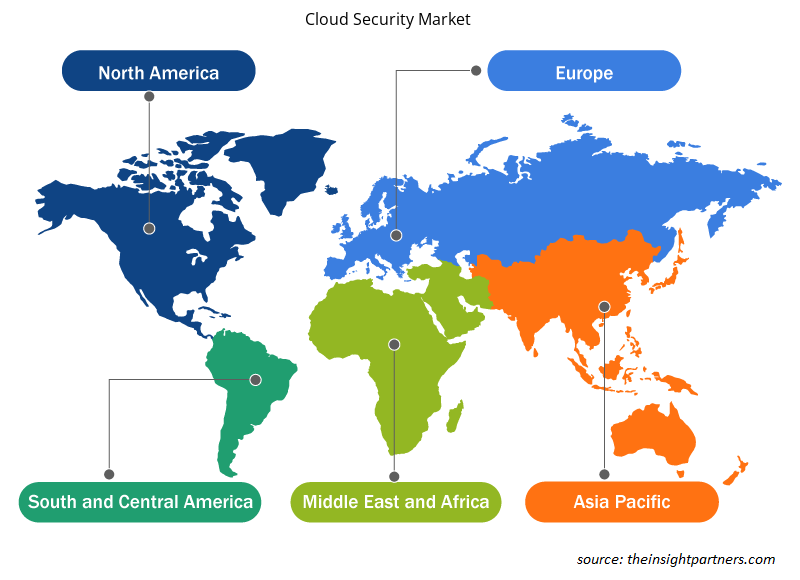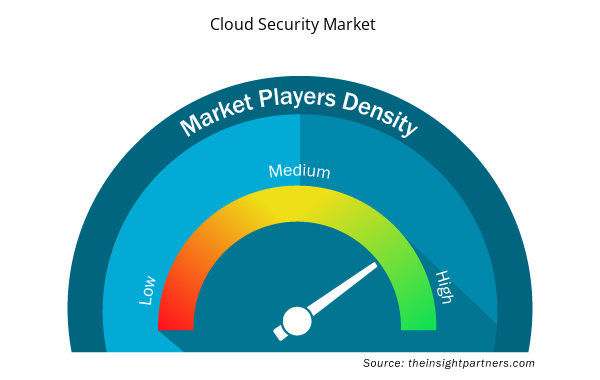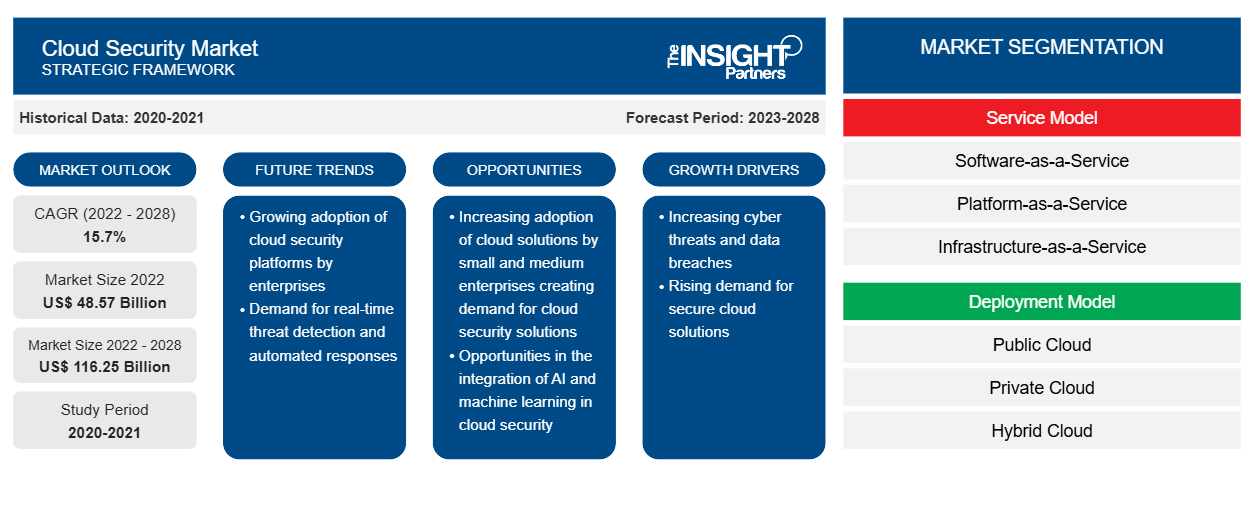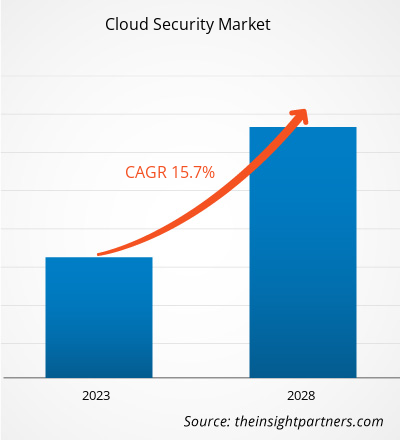من المتوقع أن ينمو سوق أمن السحابة من 48.57 مليار دولار أمريكي في عام 2022 إلى 116.25 مليار دولار أمريكي بحلول عام 2028؛ ومن المتوقع أن ينمو بمعدل نمو سنوي مركب قدره 15.7٪ من عام 2022 إلى عام 2028.
أصبحت صيانة الأمان أمرًا بالغ الأهمية في المؤسسات بسبب العدد المتزايد من الخروقات عبر الإنترنت والهجمات التكنولوجية. يوفر أمان السحابة مستويات عديدة من الحماية داخل البنية التحتية للشبكة ضد الوصول غير المصرح به وانتهاكات البيانات وهجمات رفض الخدمة الموزعة (DDoS). في عام 2022، أجرت شركة Flexera، وهي شركة برمجيات كمبيوتر أمريكية، دراسة وتوقعت أن ما يقرب من 57٪ من المؤسسات تنقل أحمال عملها إلى السحابة. كما نقل ما يقرب من 6 من كل 10 شركات أعمالها إلى السحابة. لذلك، فإن العدد المتزايد من الشركات التي تستخدم البنية التحتية القائمة على السحابة يدفع إلى اعتماد حلول أمان السحابة.
تشمل الشركات الكبيرة المعروفة والقوية مالياً في صناعة أمن السحابة العالمية شركة Amazon Web Services, Inc. وMicrosoft وIBM Corporation وOracle وGoogle, Inc.. ونتيجة لهذا، فإن القوة التفاوضية للمشترين في سوق أمن السحابة عالية جدًا. وعلاوة على ذلك، نظرًا للتقدم التكنولوجي في أمن السحابة وزيادة خدمات الحاويات المُدارة، فمن المتوقع أن تظل القوة التفاوضية للمشترين عالية خلال الفترة 2019-2028. تستخدم الشركات الكبرى في سوق أمن السحابة استراتيجيات مختلفة أثناء التخطيط لنماذج الحلول والخدمات لمختلف القطاعات الصناعية. ومن المتوقع أن يفرض التقدم المستمر في قطاع التكنولوجيا ضغوطًا على مزودي أمن السحابة للتكيف مع التغييرات للحفاظ على مكانتهم في السوق.
قم بتخصيص هذا التقرير ليناسب متطلباتك
ستحصل على تخصيص لأي تقرير - مجانًا - بما في ذلك أجزاء من هذا التقرير، أو تحليل على مستوى الدولة، وحزمة بيانات Excel، بالإضافة إلى الاستفادة من العروض والخصومات الرائعة للشركات الناشئة والجامعات
- احصل على أهم اتجاهات السوق الرئيسية لهذا التقرير.ستتضمن هذه العينة المجانية تحليلاً للبيانات، بدءًا من اتجاهات السوق وحتى التقديرات والتوقعات.
رؤى إقليمية حول سوق أمن السحابة
لقد قام المحللون في Insight Partners بشرح الاتجاهات والعوامل الإقليمية المؤثرة على سوق أمن السحابة طوال فترة التنبؤ بشكل شامل. يناقش هذا القسم أيضًا قطاعات سوق أمن السحابة والجغرافيا في جميع أنحاء أمريكا الشمالية وأوروبا ومنطقة آسيا والمحيط الهادئ والشرق الأوسط وأفريقيا وأمريكا الجنوبية والوسطى.

- احصل على البيانات الإقليمية المحددة لسوق أمن السحابة
نطاق تقرير سوق أمن السحابة
| سمة التقرير | تفاصيل |
|---|---|
| حجم السوق في عام 2022 | 48.57 مليار دولار أمريكي |
| حجم السوق بحلول عام 2028 | 116.25 مليار دولار أمريكي |
| معدل النمو السنوي المركب العالمي (2022 - 2028) | 15.7% |
| البيانات التاريخية | 2020-2021 |
| فترة التنبؤ | 2023-2028 |
| القطاعات المغطاة | حسب نموذج الخدمة
|
| المناطق والدول المغطاة | أمريكا الشمالية
|
| قادة السوق وملفات تعريف الشركات الرئيسية |
|
كثافة اللاعبين في السوق: فهم تأثيرها على ديناميكيات الأعمال
يشهد سوق أمن السحابة نموًا سريعًا، مدفوعًا بالطلب المتزايد من المستخدم النهائي بسبب عوامل مثل تفضيلات المستهلك المتطورة والتقدم التكنولوجي والوعي المتزايد بفوائد المنتج. ومع ارتفاع الطلب، تعمل الشركات على توسيع عروضها والابتكار لتلبية احتياجات المستهلكين والاستفادة من الاتجاهات الناشئة، مما يؤدي إلى زيادة نمو السوق.
تشير كثافة اللاعبين في السوق إلى توزيع الشركات أو المؤسسات العاملة في سوق أو صناعة معينة. وهي تشير إلى عدد المنافسين (اللاعبين في السوق) الموجودين في مساحة سوق معينة نسبة إلى حجمها أو قيمتها السوقية الإجمالية.
الشركات الرئيسية العاملة في سوق أمن السحابة هي:
- خدمات الويب من أمازون
- مايكروسوفت
- شركة جوجل المحدودة
- أوراكل
- شركة آي بي إم
إخلاء المسؤولية : الشركات المذكورة أعلاه ليست مرتبة بأي ترتيب معين.

- احصل على نظرة عامة على أهم اللاعبين الرئيسيين في سوق أمان السحابة
تم تقسيم سوق أمن السحابة إلى خمس مناطق رئيسية - أمريكا الشمالية وأوروبا وآسيا والمحيط الهادئ والشرق الأوسط وأفريقيا وأمريكا الجنوبية. في عام 2022، قادت أمريكا الشمالية السوق بحصة كبيرة من الإيرادات، تليها أوروبا. علاوة على ذلك، من المتوقع أن تسجل منطقة آسيا والمحيط الهادئ أعلى معدل نمو سنوي مركب في السوق من عام 2022 إلى عام 2028.
تعد Amazon Web Services, Inc. وMicrosoft وIBM Corporation وOracle وTrend Micro Incorporated وVMware, Inc. وPalo Alto Networks, Inc. وCisco Systems, Inc. وCheck Point Software Technologies Ltd. وGoogle, Inc. من بين اللاعبين الرئيسيين العاملين في سوق أمان السحابة. يوفر تقرير السوق رؤى تفصيلية للسوق، مما يساعد اللاعبين الرئيسيين على وضع استراتيجيات للنمو في السنوات القادمة.
- التحليل التاريخي (سنتان)، السنة الأساسية، التوقعات (7 سنوات) مع معدل النمو السنوي المركب
- تحليل PEST و SWOT
- حجم السوق والقيمة / الحجم - عالميًا وإقليميًا وقطريًا
- الصناعة والمنافسة
- مجموعة بيانات Excel


- Intraoperative Neuromonitoring Market
- Point of Care Diagnostics Market
- Electronic Toll Collection System Market
- Biopharmaceutical Contract Manufacturing Market
- Water Pipeline Leak Detection System Market
- Drain Cleaning Equipment Market
- Gas Engine Market
- Dealer Management System Market
- Fishing Equipment Market
- Frozen Potato Market

Report Coverage
Revenue forecast, Company Analysis, Industry landscape, Growth factors, and Trends

Segment Covered
This text is related
to segments covered.

Regional Scope
North America, Europe, Asia Pacific, Middle East & Africa, South & Central America

Country Scope
This text is related
to country scope.
الأسئلة الشائعة
Amazon Web Services, Inc.; Microsoft; IBM Corporation; Oracle; Trend Micro Incorporated; VMware, Inc.; Palo Alto Networks, Inc.; Cisco Systems, Inc.; Check Point Software Technologies Ltd.; and Google, Inc. are the leading companies in the cloud security market.
Cloud-native applications, which are created specifically to operate on the cloud, are gaining prevalence with the growing use of cloud platforms; therefore—surge in technological advancements in cloud security is one of the major trends in the cloud security market.
North America dominated the cloud security market in 2021. With higher penetration of large and mid-sized companies, there is a growing frequency of cyber-attacks and the increasing number of hosted servers. Moreover, growing number of cybercrime and the production of new cyberattacks, as well as surge in usage of cloud-based solutions are all becoming major factor propelling the market growth in the region.
With growing adoption of artificial intelligence & machine learning, cybersecurity teams are expected to gain valuable tools for averting security breaches and focusing more on innovation to achieve their long-term business goals. Also, surge in number of governments initiatives & investments in cloud technology are anticipated to create growth opportunity for the market players in the coming years.
Due to rising number of cyberattacks, businesses are implementing cutting-edge cybersecurity tools to identify risks and reduce costs associated with data breaches. Moreover, surge in usage of cloud-based solutions & managed security services and increasing managed container services are propelling the growth of the cloud security market.
The List of Companies - Cloud Security Market
- Amazon Web Services, Inc.
- Microsoft
- Google LLC
- Oracle
- IBM Corporation
- Cisco System, Inc.
- Trend Micro Incorporated
- Palo Alto Networks, Inc.
- Checkpoint Software Technologies
- VMware, Inc.
The Insight Partners performs research in 4 major stages: Data Collection & Secondary Research, Primary Research, Data Analysis and Data Triangulation & Final Review.
- Data Collection and Secondary Research:
As a market research and consulting firm operating from a decade, we have published and advised several client across the globe. First step for any study will start with an assessment of currently available data and insights from existing reports. Further, historical and current market information is collected from Investor Presentations, Annual Reports, SEC Filings, etc., and other information related to company’s performance and market positioning are gathered from Paid Databases (Factiva, Hoovers, and Reuters) and various other publications available in public domain.
Several associations trade associates, technical forums, institutes, societies and organization are accessed to gain technical as well as market related insights through their publications such as research papers, blogs and press releases related to the studies are referred to get cues about the market. Further, white papers, journals, magazines, and other news articles published in last 3 years are scrutinized and analyzed to understand the current market trends.
- Primary Research:
The primarily interview analysis comprise of data obtained from industry participants interview and answers to survey questions gathered by in-house primary team.
For primary research, interviews are conducted with industry experts/CEOs/Marketing Managers/VPs/Subject Matter Experts from both demand and supply side to get a 360-degree view of the market. The primary team conducts several interviews based on the complexity of the markets to understand the various market trends and dynamics which makes research more credible and precise.
A typical research interview fulfils the following functions:
- Provides first-hand information on the market size, market trends, growth trends, competitive landscape, and outlook
- Validates and strengthens in-house secondary research findings
- Develops the analysis team’s expertise and market understanding
Primary research involves email interactions and telephone interviews for each market, category, segment, and sub-segment across geographies. The participants who typically take part in such a process include, but are not limited to:
- Industry participants: VPs, business development managers, market intelligence managers and national sales managers
- Outside experts: Valuation experts, research analysts and key opinion leaders specializing in the electronics and semiconductor industry.
Below is the breakup of our primary respondents by company, designation, and region:

Once we receive the confirmation from primary research sources or primary respondents, we finalize the base year market estimation and forecast the data as per the macroeconomic and microeconomic factors assessed during data collection.
- Data Analysis:
Once data is validated through both secondary as well as primary respondents, we finalize the market estimations by hypothesis formulation and factor analysis at regional and country level.
- Macro-Economic Factor Analysis:
We analyse macroeconomic indicators such the gross domestic product (GDP), increase in the demand for goods and services across industries, technological advancement, regional economic growth, governmental policies, the influence of COVID-19, PEST analysis, and other aspects. This analysis aids in setting benchmarks for various nations/regions and approximating market splits. Additionally, the general trend of the aforementioned components aid in determining the market's development possibilities.
- Country Level Data:
Various factors that are especially aligned to the country are taken into account to determine the market size for a certain area and country, including the presence of vendors, such as headquarters and offices, the country's GDP, demand patterns, and industry growth. To comprehend the market dynamics for the nation, a number of growth variables, inhibitors, application areas, and current market trends are researched. The aforementioned elements aid in determining the country's overall market's growth potential.
- Company Profile:
The “Table of Contents” is formulated by listing and analyzing more than 25 - 30 companies operating in the market ecosystem across geographies. However, we profile only 10 companies as a standard practice in our syndicate reports. These 10 companies comprise leading, emerging, and regional players. Nonetheless, our analysis is not restricted to the 10 listed companies, we also analyze other companies present in the market to develop a holistic view and understand the prevailing trends. The “Company Profiles” section in the report covers key facts, business description, products & services, financial information, SWOT analysis, and key developments. The financial information presented is extracted from the annual reports and official documents of the publicly listed companies. Upon collecting the information for the sections of respective companies, we verify them via various primary sources and then compile the data in respective company profiles. The company level information helps us in deriving the base number as well as in forecasting the market size.
- Developing Base Number:
Aggregation of sales statistics (2020-2022) and macro-economic factor, and other secondary and primary research insights are utilized to arrive at base number and related market shares for 2022. The data gaps are identified in this step and relevant market data is analyzed, collected from paid primary interviews or databases. On finalizing the base year market size, forecasts are developed on the basis of macro-economic, industry and market growth factors and company level analysis.
- Data Triangulation and Final Review:
The market findings and base year market size calculations are validated from supply as well as demand side. Demand side validations are based on macro-economic factor analysis and benchmarks for respective regions and countries. In case of supply side validations, revenues of major companies are estimated (in case not available) based on industry benchmark, approximate number of employees, product portfolio, and primary interviews revenues are gathered. Further revenue from target product/service segment is assessed to avoid overshooting of market statistics. In case of heavy deviations between supply and demand side values, all thes steps are repeated to achieve synchronization.
We follow an iterative model, wherein we share our research findings with Subject Matter Experts (SME’s) and Key Opinion Leaders (KOLs) until consensus view of the market is not formulated – this model negates any drastic deviation in the opinions of experts. Only validated and universally acceptable research findings are quoted in our reports.
We have important check points that we use to validate our research findings – which we call – data triangulation, where we validate the information, we generate from secondary sources with primary interviews and then we re-validate with our internal data bases and Subject matter experts. This comprehensive model enables us to deliver high quality, reliable data in shortest possible time.


 احصل على عينة مجانية لهذا التقرير
احصل على عينة مجانية لهذا التقرير